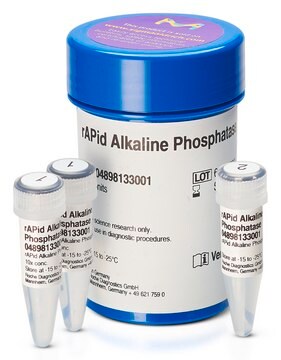Wszystkie zdjęcia(1)
Kluczowe dokumenty
API-RO
Roche
Alkaline Phosphatase (AP)
grade I, from calf intestine
Synonim(y):
AP, Alkaline Phosphatase
Zaloguj sięWyświetlanie cen organizacyjnych i kontraktowych
About This Item
Polecane produkty
pochodzenie biologiczne
bovine (calf) intestine
Poziom jakości
Formularz
suspension
opakowanie
pkg of 1,500 U (10108138001)
pkg of 7,500 U (10108146001)
producent / nazwa handlowa
Roche
optymalne pH
8.0-10.5
Absorpcja
7.6 at 278 nm (10 mg AP/ml)
temp. przechowywania
2-8°C
Opis ogólny
W temperaturze 37 °C z fosforanem 4-nitrofenylu jako substratem i dietanoloaminą jako buforem (400 U/mg w temperaturze 25 °C z fosforanem 4-nitrofenylu jako substratem i glicyną jako buforem).
Orthophosphoric-monoester phosphohydrolase (alkaline optimum)
Alkaline phosphatase catalyzes the removal of phosphate group from various compounds that are phosphorylated. It hydrolyzes 5′-monophosphate groups from both DNA and RNA. It can also hydrolyze 5′-diphosphate and 5′-triphosphate groups from RNA.
Alkaline phosphatase catalyzes the removal of phosphate group from various compounds that are phosphorylated. It hydrolyzes 5′-monophosphate groups from both DNA and RNA. It can also hydrolyze 5′-diphosphate and 5′-triphosphate groups from RNA.
Specyficzność
Heat inactivation: AP activity is destroyed irreversibly by incubating the enzyme at 65 °C.
Denaturation is dependent on protein concentration - using less than 10 U/ml (0.1 mol/l glycine buffer, pH 10.5, 1 mmol/l MgCl2 and 0.1 mmol/l ZnCl2), AP is inactivated by a 10 minutes incubation at 65 °C.
Denaturation is dependent on protein concentration - using less than 10 U/ml (0.1 mol/l glycine buffer, pH 10.5, 1 mmol/l MgCl2 and 0.1 mmol/l ZnCl2), AP is inactivated by a 10 minutes incubation at 65 °C.
Zastosowanie
Selective cleavage of terminal phosphate groups from oligonucleotides and in protein nucleotide exchange and deliverance. It has also been used to phosphorylate samples to distinguish between phosphate moieties present as phosphorylated glycans and phosphorylated amino acid residues.
Jakość
Contaminants: <0.0004% PDE, <0.004% ADA and A-5-MP deaminase, each
Sekwencja
AP is a dimer of identical or nearly identical subunits; each of which contains 2 molecules of Zn2+ , one tightly bound and necessary for structural stability, the other loosely bound and required for caytalytic activity. The active site contains a reactive serine.
In some mammals (e.g., humans), there are at least 3 distinguishable isoenzymes: the intestinal, the placental and the form found in bone/liver/kidney.
In some mammals (e.g., humans), there are at least 3 distinguishable isoenzymes: the intestinal, the placental and the form found in bone/liver/kidney.
Definicja jednostki
Unit Conversion: 1 Roche unit (tested at +25 °C) corresponds to ~2 to 2.5 Sigma units (tested at +37 °C).
AP activity is not expressed in Armstrong units; a conversion factor for international units is not known.
Approx. 3.8 U (grade I AP) or 4.0 U (grade II AP) [+37 °C, 4-NPP as substrate, diethanolamine as buffer, pH 9.8] = 1 U [+25 °C, 4-NPP as substrate, glycine as buffer, pH 10.5].
Biochemica Information. 87 (grade I AP) :
1.0 U [+37 °C, QC assay conditions] = 0.79 U [+30 °C, QC assay conditions] = 0.57 U [+25 °C, QC assay conditions]
AP activity is not expressed in Armstrong units; a conversion factor for international units is not known.
Approx. 3.8 U (grade I AP) or 4.0 U (grade II AP) [+37 °C, 4-NPP as substrate, diethanolamine as buffer, pH 9.8] = 1 U [+25 °C, 4-NPP as substrate, glycine as buffer, pH 10.5].
Biochemica Information. 87 (grade I AP) :
1.0 U [+37 °C, QC assay conditions] = 0.79 U [+30 °C, QC assay conditions] = 0.57 U [+25 °C, QC assay conditions]
Postać fizyczna
Suspension in 3.2 M ammonium sulfate solution, 1 mM MgCl2, 0.1 mM ZnCl2, pH approximately 7
Uwaga dotycząca przygotowania
- Activator: Divalent metal ions (Mg2+, Co2+, Mn2+)
- Amino alcohols (2-amino-2-methyl-1-propanol, diethanolamine)
Note that high concentrations of amino alcohols can as well act as competitive inhibitors (e.g., monoethanolamine in diethanolamine).
Storage conditions (working solution): The suspension is offered at a c= approx. 5 mg/ml.
If this suspension is diluted only 5 to 10-fold with further 3.2 M ammonium sulfate solution, 1 mM MgCl2, 0.1 mM ZnCl2, pH approx. 7, we would expect from general experience that a stability for some weeks might be given provided it is stored at 4 °C (no guarantee!).
Inne uwagi
For life science research only. Not for use in diagnostic procedures.
Ta strona może zawierać tekst przetłumaczony maszynowo.
Kod klasy składowania
12 - Non Combustible Liquids
Klasa zagrożenia wodnego (WGK)
WGK 1
Temperatura zapłonu (°F)
does not flash
Temperatura zapłonu (°C)
does not flash
Wybierz jedną z najnowszych wersji:
Masz już ten produkt?
Dokumenty związane z niedawno zakupionymi produktami zostały zamieszczone w Bibliotece dokumentów.
Klienci oglądali również te produkty
METHOD SUMMARY
Stephanie Ketcham
Biotechniques, 117-123 (2017)
Brian M Zeglis et al.
Nature protocols, 2(2), 357-371 (2007-04-05)
This protocol describes the syntheses and applications of two metallointercalators, Rh(bpy)2(chrysi)3+ and Rh(bpy)2(phzi)3+, that target single base mismatches in DNA. The complexes bind mismatched DNA sites specifically and, upon photoactivation, promote strand scission neighboring the mismatch. Owing to their high
Raphael Gasper et al.
Small GTPases, 1(3), 133-141 (2011-06-21)
The Ras family is the largest and most diverse sub-group of Ras-like G proteins. This complexity is further increased by the high number of regulatory Guanine nucleotide Exchange Factors (GEFs) and GTPase Activating Proteins (GAPs) that target specific members of
O Brenna et al.
The Biochemical journal, 151(2), 291-296 (1975-11-01)
A crude preparation of alkaline phosphatase (EC 3.1.3.1) from calf intestinal mucosa was purified by affinity chromatography on Sepharose-bound derivatives of arsanilic acid, which was found to be a competitive inhibitor of the enzyme. Three biospecific adsorbents were prepared for
Protokoły
Alkaline Phosphatase (AP) Protocol
Nasz zespół naukowców ma doświadczenie we wszystkich obszarach badań, w tym w naukach przyrodniczych, materiałoznawstwie, syntezie chemicznej, chromatografii, analityce i wielu innych dziedzinach.
Skontaktuj się z zespołem ds. pomocy technicznej





